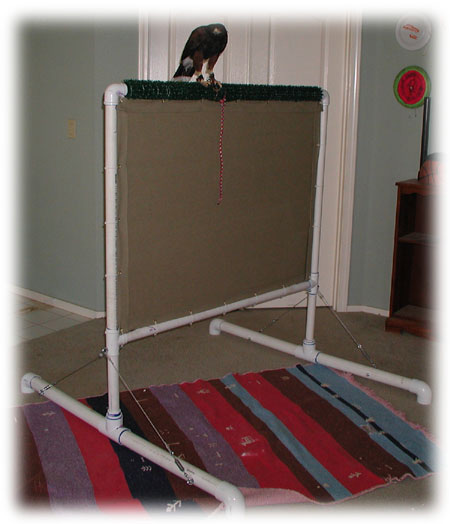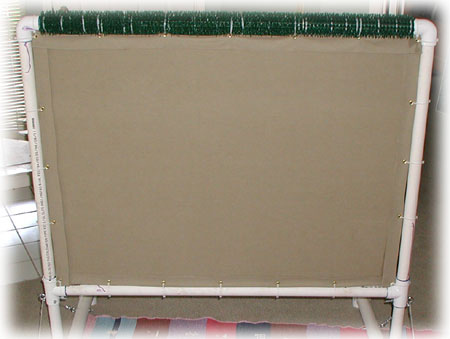If you are using PVC for a perch, you will need weight the base pieces for stability. Filling it with gravel, sand, concrete, or plaster of Paris will add the weight conveniently, and here cables were used to add even more stability. The screen is made of canvas that has been ironed for the crisp edges, then had Barge cement applied (instead of sewing) the edges together. A leather punch was used to punch holes for the brass grommets and cable ties were used to affix the screen to the frame.
If you want to create it using a wood frame, 2"x4" or 4"x4" wood posts. Be certain to seat it well on the base. If you are using wood, then the screen can be attached using furniture tacks for a neat appearance and to get it tightly stretched. The perching rail can be covered with sisal, cocoa mat, or cork.
A typical dimension for a screen perch for a Harris or a Goshawk would be 3' for the feet, 46" for the uprights, and 8' in length.
Ideally, there will actually be two screens separated a bit and set at the same width of as the perch width. This distance away from center allows the bird to more easily regain her perch. If perching several birds along the screen, make sure that the larger one cannot touch the smaller one when her wings are spread out, and then give another 8" on top of that.
The leash is one of the most important parts to a successful and safe screen perch setup as many of the birds who die on this type of perch do so because the swivel slips over the top. Several features can be done to help ensure the safety. An 1/4" eye screw can be screwed in to the top of the perching surface before wrapping the perch. It must face forward and back such that you can see through the eye when looking at the perch from the front. The leash will pass through this and keep it straight and lined up. A second eye screw can be put opposite the first underneath the perch to run the leash through. This will keep the knot away from the bird and prevent her from being able to untie herself.
Plastic sheeting, such as what comes in rolls and is about 3 millimeters thick, can be used to prevent errant mutes.
 |
A screen perch |
 |
More details |